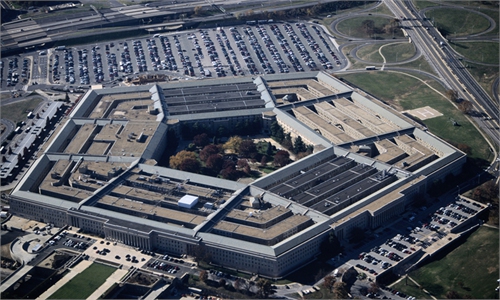
A formation of Dongfeng-41 intercontinental strategic nuclear missiles takes part in a military parade celebrating the 70th anniversary of the founding of the People's Republic of China in Beijing, capital of China, October 1, 2019. Photo: Xinhua
The Pentagon released an annual report on "Military and Security Developments Involving the People's Republic of China" on Tuesday. To make its target more obvious, the Pentagon hyped up the so-called Chinese military threat in a crude way. It claims China "has the largest navy in the world" and that China will "at least double" the size of its nuclear warhead stockpile over the next decade.
By saying China "has the largest navy in the world," the Pentagon is deliberately misleading the discussion. The report highlighted that China has 350 ships and submarines compared with approximately 293 US ships. Yet the number itself can hardly speak for combat capabilities. Quite a few Chinese ships are small and medium-sized vessels. In terms of capital ships, namely leading or primary ships in naval fleets, the number the US Navy has clearly gives them the absolute upper hand.
The US Navy has 11 large nuclear-powered fleet carriers, and also the largest carriers in the world which can carry about 80 fighter jets each. Granted, the Chinese navy has been developing rapidly over the past 20 years. It now has two conventional-powered (non-nuclear-powered) aircraft carriers, more amphibious assault ships, and 10,000 ton-class guided missile destroyers. However, compared with the number of the US, the Chinese Navy still lags behind.
However, the US believes its absolute military superiority in the Pacific may be shaken by Chinese military's rising power. So it tends to seize every opportunity, including in its annual reports, to exaggerate the strength of the Chinese navy. It frightens its traditional military allies by noting that the Chinese navy is growing at a scary rate. It tells those regional US allies that they are in need of more protection from the US. Of course, the Pentagon also wants to seek more budget from the US Congress. By portraying the Chinese army as threatening, it makes up more excuses to reach its goal.
Compared with previous relevant US reports, the biggest difference of the latest one is the Pentagon has done more calculations on nuclear deterrence of both China and the US. It estimates that China's current nuclear warhead stockpile is in the low-200s and will double in size in the coming 10 years. The figure is purely US unilateral speculation without any evidence to prove its authenticity.
How many nuclear weapons China has now and will develop in the future depends on China's strategic needs. Beijing will not engage in a nuclear arms race, especially with the US. The number of China's nuclear warhead stockpile, no matter whether it's in the low-200s or will double the size, is much less than even a fraction of the US' 3,800 nuclear warheads. Such a comparison of number shows that China's nuclear weapons are developed for counterattack. They are a force to prevent others' nuclear deterrence — or nuclear blackmail.
China's future nuclear development will also be made and adjusted based on the needs of China's national defense and strategy. The number is not our primary task, but elevating the quality is. The focus of China's nuclear development should be to boost the ability of precision and delivery of nuclear weapons. It must improve the missiles to strike further and make them more capable to carry more decoy projectiles in order to enhance Chinese nuclear weapons' defense penetration abilities.
The Pentagon has put quite a lot of effort into doing calculations on China's nuclear warheads because it intends to adjust its own focus of military development. Voices calling to restart nuclear tests are mushrooming within the US. Given that the country has already abandoned the Intermediate-Range Nuclear Forces Treaty, it is highly likely to hype up the so-called Chinese nuclear threat in an attempt to pave the way for making its own breakthroughs in nuclear developments. The possibility of the US starting to develop new types of nuclear weapons and resuming its nuclear tests cannot be ruled out.
The annual report on Chinese military is a provocation, as US' increasing aggressive military moves overseas. Given its inextricable domestic problems (including the world's highest novel coronavirus infection rates and death toll, and sharp contradictions between different racial groups), politicians from Washington have no alternative but to divert the public's attention from the crisis at home. So it picked a relatively strong and convenient rival - China.
But all US provocative moves are closely monitored by China. Once US' reconnaissance planes or warships approach China's air defense identification zone or islands and reefs, Chinese fighter jets and navy ships will immediately starts off and expel them. The US can hardly take any advantage of such operations.
The interactions will normally end after the expulsion taken by the Chinese side. This means the US will retreat in the face of China's ability of counterattacks. It demonstrates that US provocative actions are weak, and lack of confidence in nature.
From time to time, the Pentagon has hinted it does not wish for a real outbreak of war. It keeps its provocations under the pressure of Washington. In the meantime it sends signals to keep communication with the Chinese military. It simultaneously keeps stirring up troubles while attempting to control the crisis.
The Pentagon is acting as a hatchet man for the White House while its own strength and confidence is declining. Deep down in its heart, it does not want to instigate a real large-scale war. As a result, it is behaving like nothing more than a torn, timid hatchet man.
The author is a Beijing-based military analyst. opinion@globaltimes.com.cn

